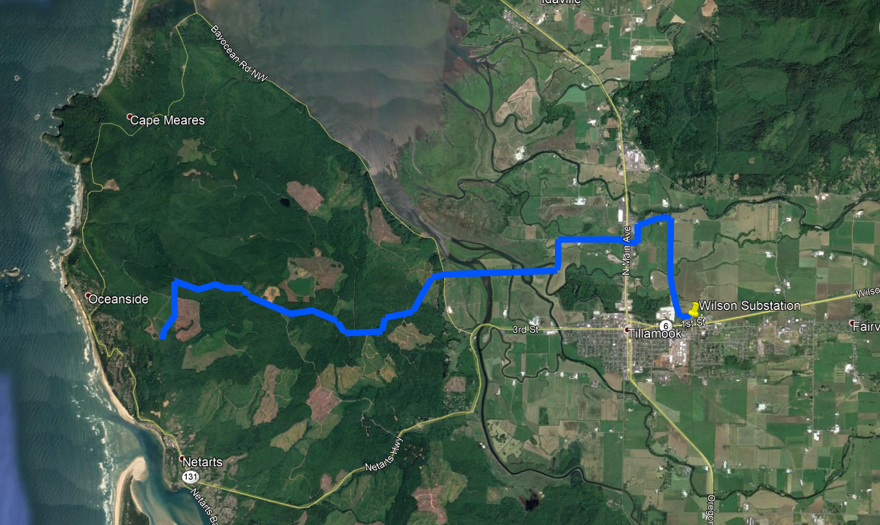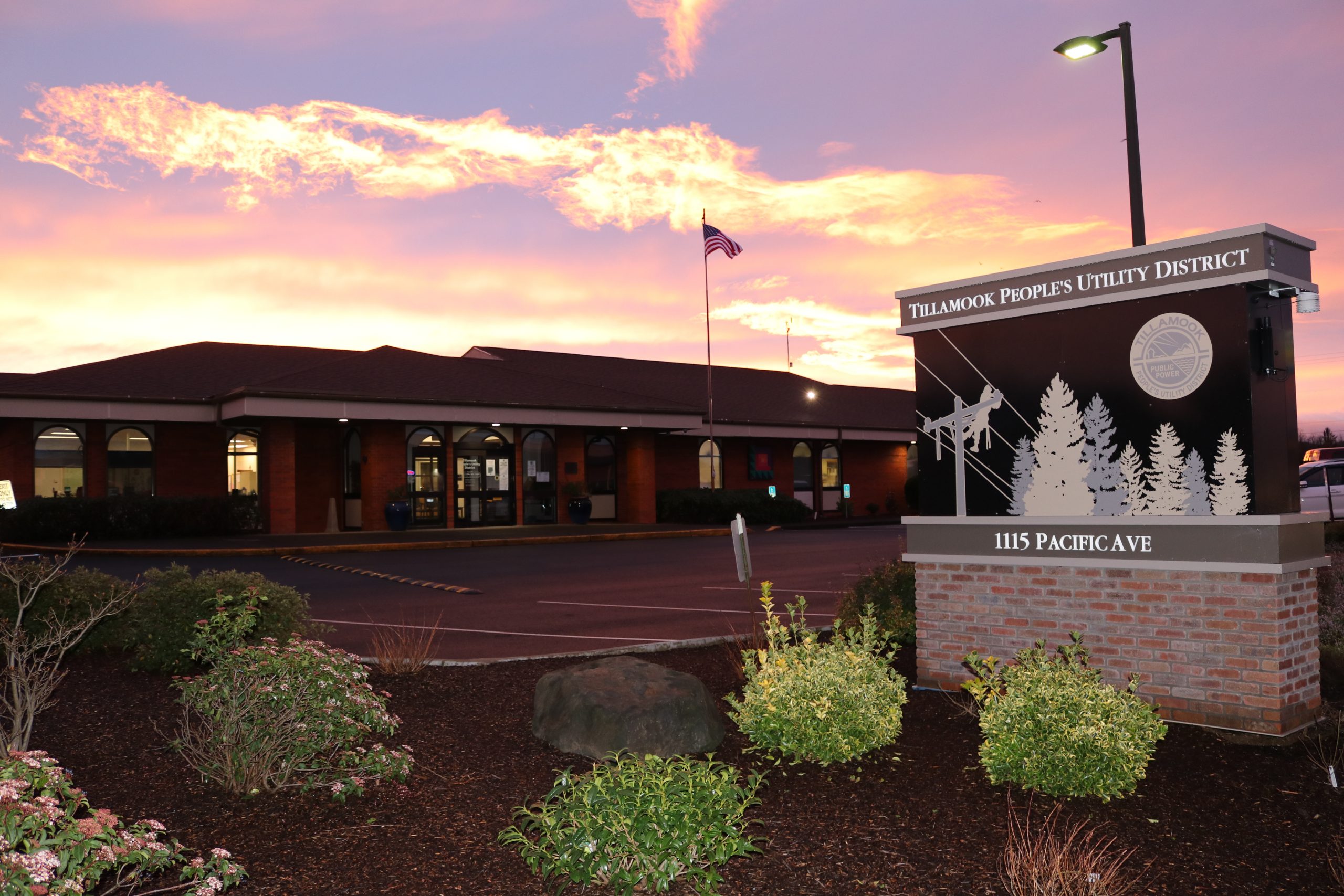EDITOR’S NOTE: The TPUD Board Meeting was well-attended this week from a “call-to-action” from social media. With many citizens concerned about the TPUD Oceanside/Netarts Transmission line, which will starting construction soon. The Pioneer reached out to TPUD for a statement about this complex project that’s been decades in planning. Aging infrastructure and a single feed to the Oceanside/Netarts area are not an equitable use of the public utilities services. TPUD is tasked with providing reliable service to all customers. After over a decade of studies, community meetings and reviewing various options, a route has been determined, and negotiations for easements and right-of-ways will begin soon as well. Here is an update from TPUD about the much needed new substation and transmission line. The complete history of this project can be found on the TPUD website. See links below.
Statement from Tillamook PUD (March 18, 2022)
As a public entity, it is the responsibility of Tillamook PUD to ensure equity in providing safe and reliable electricity to all customers, regardless of where they are in our service territory. Enhancing the electric system and planning for the future is a priority of Tillamook PUD. When spending funds to invest in system improvements and new infrastructure, it is the PUD’s obligation to ensure the most viable option is ultimately constructed.
There are approximately 2,000 customers in the southwest Tillamook, Whiskey Creek, Netarts, and Oceanside areas that are provided electric service by a single radial feeder, electric circuit W51. This radial feed stretches over 10 miles to Oceanside, with most of the customers concentrated at the end of the feeder. There is no redundancy to serve these customers, therefore when an issue occurs causing a power outage on this feeder there is no option to isolate the section where the issue is, and restore power to a portion of customers while repairs are being made. All customers beyond the isolated point of the cause of the outage remain without power until repairs can be made. Additionally, based on outage data collected from 2011 to 2021, the customer-hours without power in this area, (which is the duration of an outage multiplied by the number of customers without power during this time) is 1.7 times higher than the next worst performing feeder and is 5.5 times higher than an average feeder in the Tillamook PUD system.
Tillamook PUD’s Wilson River substation in Tillamook currently provides power to roughly one-third of Tillamook PUD customers, including the top five commercial and industrial electrical users in the service area. This substation is approaching capacity limits due to rising electricity demand in the communities of Tillamook, Bay City, Oceanside, Netarts, and surrounding areas. Further, high winter peak load conditions cause the transformers in this substation to become stressed from the increased load. Under normal circumstances, the total electrical load is shared by the two transformers with some room or “spare capacity” for additional load. This spare capacity is used to serve additional load growth and loads from adjoining substations when they experience outages. If one transformer becomes unavailable because of an outage or failure, the other transformer is only capable of taking on a portion of the load. The remaining load can be shifted or transferred to the adjoining Trask River and Garibaldi substations if they have sufficient spare capacity. Although Tillamook PUD replaced one of the transformers in the Wilson River substation in 2019, the central Tillamook area is currently at 93% of system capacity when taking into consideration the loss of one of the main power transformers. If the increasing electrical loads at peak times exceed the capabilities of current electric system components, including conductors and transformers, this will result in forced customer outages. Compounding this issue, if a power transformer failure occurs, it could take weeks or months to repair or replace.
With a new substation in the Oceanside area, Tillamook PUD would be able to transfer about 11 MW of electrical load from the Wilson River substation to the Oceanside substation which would add substantial capacity to the central Tillamook County area. This would ease the capacity constraints at the Wilson River substation, provide a much-needed backup plan for unexpected equipment issues that could occur, and allow for future load growth.
Every customer in the Tillamook PUD electric system deserves the delivery of reliable electric power. The entire Tillamook PUD electric system is configured to provide backup electricity from an adjacent substation. There are substations throughout the service territory that supply electricity to fewer customers than what the proposed Tillamook to Oceanside transmission line substation will feed. Additionally, when the Nehalem and Nestucca transmission lines and substations were constructed, the electric load for the respective communities was less than what exists today in Netarts and Oceanside.
Multiple options to improve the electrical system in this area have been explored and discussed over the years. The need for a future transmission line and substation to feed the area was first identified in the 1963 Tillamook PUD Long Range Plan. Since then Tillamook PUD has been reviewing and developing options to increase reliability and support continual growth in the area.
Two transmission line routes were initially designed, a Netarts route in the early 2000s and a route through the City of Tillamook in 2007, however, both were not built due to location and permitting constraints. Then, in early 2015, a Citizen’s Advisory Group (CAG) was formed to evaluate a new route. The current proposed Tillamook to Oceanside transmission line route follows the route identified by the CAG with some alterations to meet State and County planning goals of following existing corridors. A portion of this route was also moved slightly north, which shortened a segment of line by about 30 percent and eliminated one farm property from the route altogether.

Alternative options to a transmission line were also reviewed. One included the rebuilding of the existing feeder W51 using much larger wires and supporting structures than required for the transmission alternative and the addition of a second distribution line from the Trask substation to Oceanside. This option would provide a looped feed with two circuits to Netarts and Oceanside. However, upon review of the reliability of this alternative, it was determined the service to the Whiskey Creek, Netarts, and Oceanside areas would improve, but the outages would likely remain higher than what an average system feeder experiences. Based on current estimates, this alternative would cost $22.6 million. Given the costs associated and only modest upgrades being made to area reliability, this alternative option provides the least amount of improvement in reliability and capacity. To improve the reliability of this option, undergrounding of the existing feeder along highway 131 and undergrounding the majority of
the Trask feeder was analyzed. This option was estimated to cost over $28 million and still requires the acquisition of over 80 easements on private properties.
It is important to note that when building new infrastructure, it is sometimes necessary to secure easements through public and private property to build infrastructure. For projects that require easements, Tillamook PUD staff strive to work collaboratively with property owners on the terms and structure of easement requests. Tillamook PUD has no interest in taking any property in Tillamook County through eminent domain. However, Tillamook PUD will be seeking easements through eminent domain if necessary, which has only occurred once in our 70-year history.
Additionally, Tillamook PUD is not building the Tillamook to Oceanside transmission line for the delivery of offshore wind or wave energy. The coastline along the Tillamook PUD service territory has not been identified as an area sustainable for this type of power generation. There are no renewable energy permit areas currently located in the Tillamook PUD service territory.
(Oregon Territorial Sea Plan, Oregon Ocean Information- The Oregon Department of Land Conservation and Development. https://www.oregonocean.info/index.php/oceandocuments/planning/territorial-sea-plan2/part-5-marine-renewable-energy-facility-siting-2009-2013-2019/1897-tsp-part-5-final-text-and-appendix-a-2019).
At the February 15, 2022, Tillamook PUD Board of Directors meeting, the Directors voted to approve the Tillamook to Oceanside Transmission Line Contract concluding successful negotiations of the terms and conditions of the contract. The Board also approved the purchase of the Oceanside substation transformer. The next step in the project is working with property owners to secure easements.

For additional project information, including historical documentation, route maps, and project updates, visit our website at https://www.tpud.org/news-community/projects/tillamookoceanside-transmission-line/.


